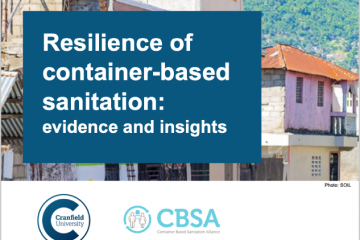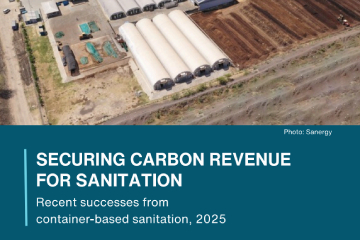Conversations about financing sanitation can sometimes feel all over the place. They jump from the latest shiny funding trend to misaligned priorities, all while skipping over the big picture. So say the researchers at the University of Technology Sydney, who are also suggesting a more productive path forward using the ‘sustainable cost recovery’ framework. This comprehensive approach, already proven in the water sector, offers a way to bring much-needed clarity and focus to our discussions.
While the framework doesn’t isn’t a one-size-fits-all solution to solving all the complexities of urban sanitation financing, it does offer a way to spark fresh thinking and more constructive approaches. By encouraging us to step back, think holistically, and build smarter, fairer financing strategies, it aligns closely with the CBSA’s mission to address financing gaps and promote inclusive, sustainable sanitation solutions.
“While none will ‘solve’ urban sanitation financing—an unrealistic expectation for complex situations—the principles can prompt new thinking and identification of pathways to progress urban sanitation financing in constructive directions.”
Carrard, N., Willetts, J., Kome, A. et al. Sustainable cost recovery principles can drive equitable, ongoing funding of critical urban sanitation services
1. Fair financing for the public good
The framework’s first principle focuses on ensuring an appropriate mix of tariffs, taxes, and transfers (the “3 Ts”) to support equitable and sustainable sanitation financing. CBS providers, including members of the CBSA, have been pioneering innovative ways to narrow the funding gap, such as selling reuse products, exploring carbon credits, and more. These efforts are an important part of the solution but, as the article highlights, they alone cannot close the gap. Acknowledging this, the authors argue that sanitation financing will, in the most part, need to lean on an appropriate mix of the 3 Ts.
Within this, achieving fair financing will require rethinking how costs are shared. Households with sewered systems often pay significantly less than those relying on onsite systems. Given this, the writers question whether it would it make sense to distribute the costs of both sewered and non-sewered sanitation more equitably, given that everyone benefits from a clean, healthy environment. As an alliance, CBSA actively supports mechanisms that reflect the public good nature of sanitation, working to mainstream container based sanitation and unlock public contracts for CBS services. A holistic approach to cost-sharing wouldn’t just promote fairness – it could also help to build financial stability for CBS providers while also reducing the burden on underserved communities.
2. Predictable and lasting financing streams
Predictable public investment is another cornerstone of the sustainable cost recovery framework. Many governments, funders, and investors still treat sanitation like traditional public infrastructure, prioritizing large upfront capital investments while underfunding ongoing operational and maintenance costs. This approach is particularly ill-suited to CBS, which typically requires lower initial capital but sustained operational funding. CBSA is addressing this challenge head-on by promoting financing models that ensure consistent, long-term funding, including the potential of performance-based funding mechanisms to secure ongoing financial support for CBS services.
The shift to predictable investment is crucial for enabling more widespread public contracting of CBS. In recognition of the social, environmental, and economic benefits of providing sanitation to all, the public sector and external donors have both chosen to subsidise CBS services to date. However, these subsidies have tended to be limited and time-bound, which have constrained the expansion of CBS services and limited their potential. More widespread predictable funding means CBS providers can plan, expand, and deliver services where they’re most needed. Governments like Ghana, with its ring-fenced sanitation funds, and cities like Dakar, with national government transfers, show us how it can be done.
3. Affordable for all and sustainable for providers
The final principle tackles the challenge of affordability for users and sustainability for providers—a balancing act that CBS providers know all too well. Many CBS services are designed to reach low-income communities, yet user fees rarely cover the full cost of safe and inclusive sanitation.
Remember the GSMA’s helpful graphic of the “pick two problem”? Affordable, safely managed, or financially sustainable services — in most instances you can only have two. Thankfully, it’s becoming more widely accepted that sanitation is a public good that requires subsidy and that there no such thing as “low-cost” sanitation – not if it’s safe and inclusive.
This ‘affordable tariff policy principle’ is transformative as it requires authorities to take a systems-wide view considering all the costs across the entire sanitation service lifecycle, from emptying and transport to treatment, identifying where subsidies might be required to find a balance that works for both users and service providers.

Getting our house in order for wider conversations
As the article concludes, language and narrative matter. This is also highlighted by Virginia Roaf’s ongoing work examining how narratives across disciplines – from public health to urban planning – impact access to sanitation in informal settlements. She continues to explore these narratives with the aim to reconcile them with the sanitation targets of the SDGs, to enable a more integrated approach to addressing sanitation challenges.
With this important work underway, it’s the perfect time for the sanitation sector to start to align its own narrative, grounded in the sustainable cost recovery framework. CBSA is committed applying the sustainable cost recovery framework in its work to shift the broader narrative around sanitation. As we work to resolve funding challenges, aligning our understanding of the financial needs and opportunities will allow us to engage in more productive, focused conversations with others about how to provide equitable and sustainable sanitation services for all.


